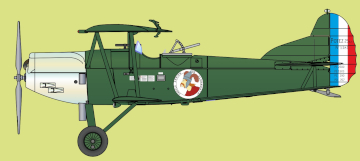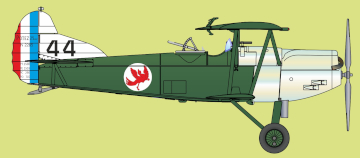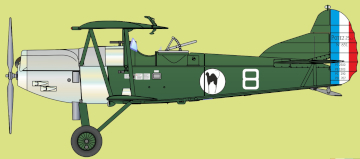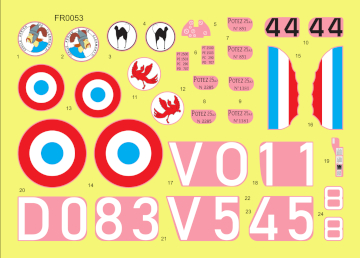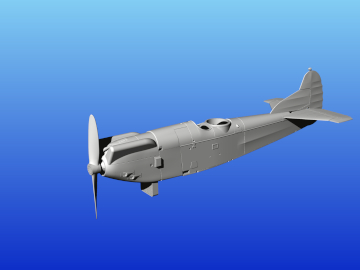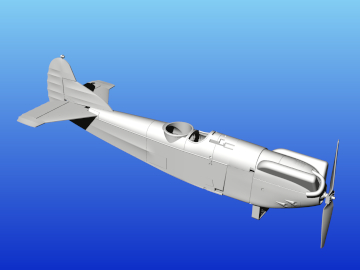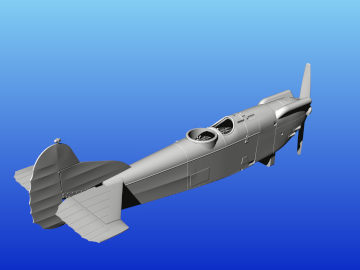FR0053 Potez 25 Renault 12 Kg
History:
Henry Potez created the Société des Avions Potez in 1921 after working with Marcel Bloch in the S.E.A. during WWI. He assigned the design of the Potez 25 to Louis Coroller. Of mixed wood & metal construction and powered by a 450 ch Lorraine-Dietrich 12 Eb engine, the Potez 25 prototype is thought to have first flown early in 1925.

The first prototype (25.1) was transferred to S.T.Aé in 1925 for testing, whilst an unarmed prototype (25.2) made a tour of European countries to demonstrate the viability of the design. This indicated the need for some modifications, the most significant being an increase of the wingspan to 14.16 m.
The Potez 25 was one of the most widely built French aircraft between the World Wars. Most aircraft were powered by Lorraine 12 Eb, Hispano-Suiza, or Gnome-Rhône (a licence-built Bristol Jupiter) engines, whilst some used Renault, Farman, or Salmson power. Either Potez or Messier landing gear was fitted and three styles of tailfins employed. This very versatile design was operated by about 20 countries and was still in use at the outbreak of WWII.
The Potez 25, in its various engines, was used by the following countries: France (several hundred), Poland, Romania, Abyssinia, Manchuria, Japan, Paraguay, Portugal, Uruguay, Yugoslavia, Brazil, Estonia, Finland, Switzerland, Guatemala, Greece and Spain. It wass also used by Aéropostale in South America to cross the Andes (two modified A2s with Lorraine engines, three others in a modified TOE version). It was built under license by Yugoslavia, Romania and Portugal. The Potez 25 was used in conflicts by Paraguay (Chaco War), Greece, Yugoslavia, Japan, Brazil and France, where some aircraft were still being employed in 1940 in schools or for liaison work.
The Renault engine installation for the Potez 25 was distinguished by an angled exhaust pipe that passed in front of the right-hand cylinder group and emerged to the right of it, giving it a distinctive appearance.
French Potez 25s powered by Renault engines used either the long 12Kg direct drive rated at 550 ch, with 261 built or the short 12Jb rated at 500 ch, with 307 built. Most of these aircraft had tall tail-fins like those fitted to Hispano-Suiza-powered Potez 25s. Some Renault-powered aircraft were later modified with dual controls and a windscreen for an instructor and used extensively for training until 1940.
In 1928, Brazil received six Potez 25 A2/B2 powered by a 480 cv Renault 12Kd engine (a short engine designated 12Jb for export). These had a rectangular tail-fin like most Salmson-powered Potez 25s had, and a 14 m wingspan similar to the first French Potez 25s. They were sent to the Campo dos Afonsos Military Aviation School in Rio de Janeiro. Initially serial numbered 7 to 12, they were renumbered K-511 to K-515 in 1929 and likely served until 1932.
Specifications (Renault 12Kg, 1932): reconnaissance (A2) and bombing (B2) two-seater biplane. 550 ch Renault 12Kg direct drive engine. Wingspan 14.16 m, length 9.61 m. Maximum speed 212 km/h at 2,000 m, theoretical ceiling 6,800 m, maximum weight 2,268 kg. Armament: 1 fixed Vickers machine gun, 2 Lewis machine guns on TO7 mountings, 1 ventral Lewis machine gun
Schemes and decals:
- Landing gear of Nr2285 (Camo B) is a Messier (parts C57 et C58), not a Potez (C44 et C45), as for the two other aircraft. Instructions should be changed on this point (as well as the below profile)
- Nr 1381, Cercle Aérien Régional de Clermont-Ferrand, from October 1933 to December 1936
- Nr 2285, coded 44 black on white tail, probably Versailles, 6 ème Escadrille, École de l'Air, 1937
- Nr 851, White 8, Training Unit, Bourget-Dugny
